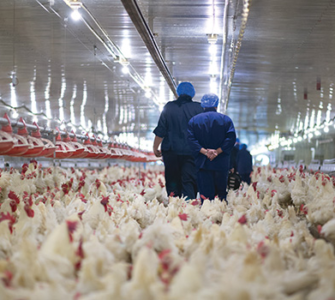Unusual presentation of bacterial septicemia in broilers tied to breeders
An unusual presentation of bacterial septicemia in broilers underscores the importance of obtaining a good history and obtaining input from bird caretakers, David French, DVM, a staff veterinarian with Sanderson Farms, told Poultry Health Today.
Broilers in two of the company’s divisions started getting sick at 35 to 40 days of age. There were respiratory signs as well as severe fibrin production in the abdominal cavity, particularly around the heart. “They had a pericarditis, a perihepatitis and a polyserositis that was so dramatic that visiting veterinarians were grabbing their cameras to get pictures of it,” French said.
The company’s two divisions are about 120 miles apart, and no connection to the problem could be found regarding movement of birds, people or other epidemiological factors. Two of the breeder flocks were up in age, but another was not, French noted.
One company division, however, recognized immediately that the problem was linked to broiler breeder flocks. The other division did not think breeders were the source and thought a short downtime, which can increase the disease challenge, was involved, he said.
‘Got our attention’
“It doesn’t make sense for a bacteria that comes from a breeder flock to not kill chicks in the first week of age but to kill them later at 35 to 40 [days]. So that was the thing that made it unique, and that’s what got our attention,” he said.
Testing was conducted for a long list of viral diseases. In one of the breeder flocks, infectious bursal disease was thought to be involved but wasn’t found in the other two breeder flocks.
In about 14% to 25% of cases, however, Enterococcus cecorum was found. No definitive diagnosis was made, but it was on the list of highly suspicious organisms. E. cecorum is usually associated with spinal abscess, leading to leg paralysis. “But we didn’t see that in these birds. It was a totally different picture. It was more of a respiratory presentation,” French continued.
Treatment with oxytetracycline of birds in all affected houses and breeder flocks was successful. “In fact, I did not have a case where I had to treat a specific house that was breaking that didn’t respond to oxytetracycline,” he said.
French added that in unique cases such as these, it takes asking the right questions and epidemiology to lead toward an approach to solving the problem. “I think that history is critically important. And gaining input from the locals that are dealing with the disease and putting together your epidemiological strategy…is critical.”
Posted on October 29, 2019

















